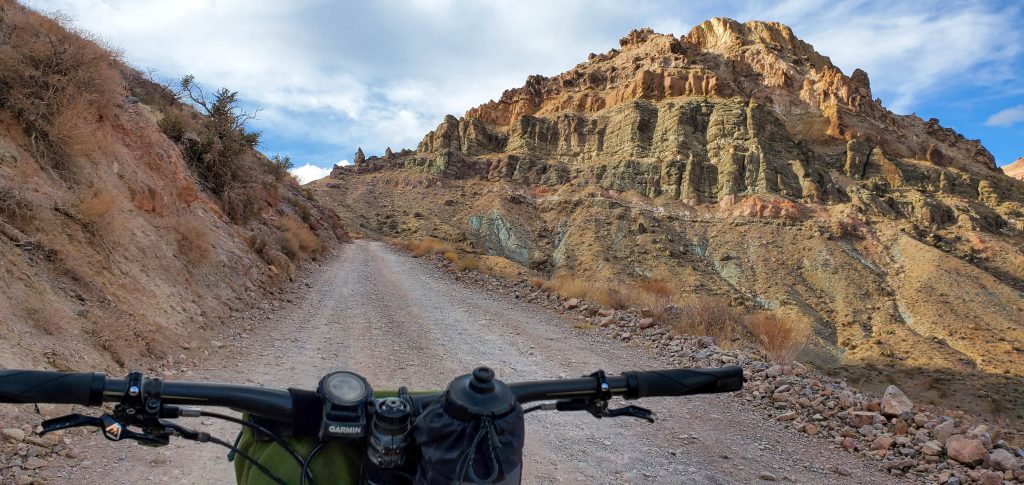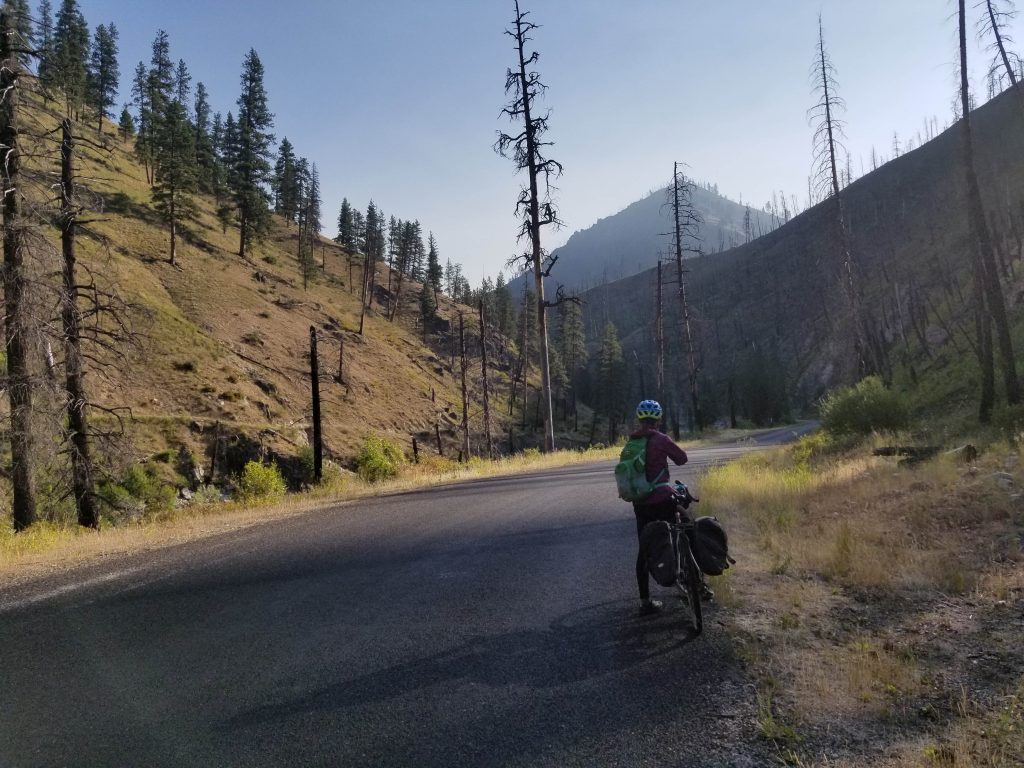The sweat is dripping down through my helmet which is sitting on top of my cycling cap, dragging sunscreen into my eyes. It’s hot and humid. We’ve been climbing for a couple of hours and we know the top is probably still a couple of hours away. At this point, I’m spelunking in the lower depths of my personal pain cave. My butt hurts, my legs don’t seem to want to spin. I’ve resorted to the, “OK. I’ll pedal for another 10 minutes and then rest” method of cycling.
Deep in this, four days in and another 7ish at least to go, self doubt is at the forefront of my thoughts. I look down at my watch. The seconds seem to be taking forever to click by. I still have another 3 minutes to go before resting. I stand up to relieve some pressure on my butt. The change feels good at first but then there is the desire from tired legs to just sit down.
A quick glance at my watch… Dammit! It’s only been 37 seconds.
I shift into an easier gear and settle back into the saddle. The lighter gear is a welcome change to standing and I settle into it. I force myself to leave the watch on the bars unattended, a skill that can take years to develop. I spin for what feels like an eternity and once I’ve convinced myself that I’m probably halfway into my next ten-minute interval, I look down.
Shit! Still got 42 seconds to go.
I spin out the rest of my ten-minute block and come to a halt in the shade. Looking back to see where Mama Bear is and I can tell she is in the midst of her own pain cave. I drop my head and breath hard. I pull my helmet down on my head to try and get the sweat to drain out of the pads and my cap to eliminate at least that small portion of the suffering.
And then I look to my left. The creek we had been following is now a few hundred feet below us in a granite gorge. That gorge is bordered by giant white spires speckled with enormous trees. The summit, while still painfully far away, is at least within view.
Involuntarily, a smile spreads across my face and I am stoked, hurting, but stoked.

#1 Spelunking in the Pain Cave
By heading into the backcountry, you must acknowledge that you are a visitor. It is often not until you are in over your head and getting back out becomes questionable that you realize how true this is. Humans are soft. We need others and almost all of us have lost the knowledge that it takes to survive without refrigeration and food abundance. This means that going into the backcountry also requires one to come back out.
Everyone has that story, or knows of that person, or at least has heard about that guy. You know the one who broke his tibia coming out of the Grand Canyon and unfortunately for him he wasn’t exiting into the infrastructure of the National Parks System. No, he was somewhere in NoZona without cell service where roads don’t exist.
Seeing that you all know that guy, I’m sure you know where this is headed. Due to lack of options, he drags himself for hours under the weight of a 50 pound pack, but makes it out and survives the ordeal.

Everyone has a pain cave, but not everyone is good at being in there.
Spelunking in said cave is a skill. It is typically developed over time by doing hard things, by seeking out discomfort, in finding the pleasure in that pain, you know, embracing the suck. As people get better at it, they tend to start to understand that there is a great deal that one can learn from dropping into that cave intentionally. One learns a lot about what they are capable of doing. Once that skill is learned, it makes pushing the boundaries, of going farther, deeper a possibility. One learns that sometimes you just have to keep going.
I’m pretty picky about who I will go into the backcountry with and with how many people. Those who are unlucky enough to be in that group are all people who possess this skill. Of all the stories we share together, we do not have any where anyone in the group was incapable or unwilling to finish what we started. Sure, everyone remembers that time that Moose got hangry, or the Planner really didn’t have enough food, or of course, the Great Snickers Incident of 2020, but we always finished.
To spelunk in the pain cave, to hold your shit together, to keep moving, the ability to finish regardless of what happens, in my opinion, is by far the most important thing you can take into the backcountry.

#2 Improvisation
It’s such a shitty place to be that there is a cliché about it.
We were only a couple of hours in to what is still one of the most memorable trips I have ever been on. The day started with a short, steep hike down to the river. We stuffed our boats full of our gear for the next couple of days, blew them up and put in. I feel comfortable saying that everyone was giddy.
The river was low, but our packrafts gave us the ability to bounce off of rocks and scrape past most of the obstacles and low spots. The water we were on flowed through amazing, tall, red sandstone walls. The beach was covered in spiny, green plants and the juxtaposition of those two things gave the river a feeling of paradise. We were all smiles and laughs and stoke.
Jason was behind me when it happened. I watched as he dug in with his paddle and the expression on his face instantly changed. He went from all smiles to oh shit. As he pulled his paddle back out of the water, I could see why. The blade had snapped off. He was literally up (well, in this instance, down) the creek without a paddle.
After the initial choice words, the realization that we all packed light so no extra paddle was had within the group, solution #1 was arrived upon: just use the one good blade kind of like a SUP paddle. This worked. Kinda. It allowed Jason to at least nudge his boat in the right direction as it flowed downstream. The nature of this particular river is anything but straight. Attempting to navigate the endless turns, rocks and other obstacles while having to alternate from side to side with your paddle was infuriating.
At our next stop, we tried the most obvious solution, a splint. We found a green branch that was about the right size, whittled it down to be a wedge and jammed it into the shaft and then the blade onto the stick. It was obvious this wasn’t going to last more than a few minutes in the river. Hmm, on to Option 3.
Shelby came up with an elaborate idea. It involved paracord, melting parts of the paddle to create notches and then cinching it all to the main shaft. If we could get the paracord tight enough, it had a good chance of working. We set about finding the things, melting the plastic and molding it the way we wanted. After wrapping the paracord around the blade it was tied onto the shaft and tightened.

While there are a myriad of ways to organize items in your pack, there are only two ways you can pack.
The first is to pack all your fears. When you head into the backcountry, carrying everything you think you will need, the first inclination is to overpack. If you’ve ever carried a pack, you have the story, you did it and have watched many others do it too. You show up with a full loaf of bread, a first aid kit that includes surgical gear, a backup paddle in addition to your extra paddle, a tarp just in case your tent pole snaps and at least one bag of chips, probably two.
The second is to pack with prudence and confidence. You recognize what you need, food, water and shelter. Those items are placed in the pile. Then you look at any special equipment you will need for the trip in question, this is also packed. This would be what you need, nothing more. You then double check your equipment making sure it is all in good working order and there is no reason to suspect that to change during the course of your adventure. If there is any piece of equipment that has a chance of failure, you pack a backup or a repair kit only if that failure would keep you from getting out. Like a patch kit for your packraft. That’s it.
And then you through your ability to improvise on top and you are set.
Most of the items deemed necessary when one packs with fear are either redundant or can easily be replicated with other things that are in your pack like repairing a broken paddle instead of carrying an extra. It is a good idea to consider this when analyzing your list. Is there a way to improvise this item if the need arises? If the answer is yes, toss it out.
Improvisation, much like Spelunking in the Pain Cave, is a skill. It is honed out of necessity and learned over time. Both are learned by doing. You can’t buy them (sorry if you ended up here thinking you were going to be given a list of gear to buy). You have to do hard things and figure out what you need and how to use it, and that knowledge comes from doing those hard things.

I take a step up. The sand compresses under my weight and the gear that is strapped to my back. If I’ve made any progress forward, it is mere inches. I take another step. Same result. My face is dripping from the sweat and my body isn’t too stoked about the packraft and other stuff jammed into my pack, but out planned route out and the quickest one at this point is up a fucking sand dune.
Step up, slide down. Repeat.
This was the same trip that resulted in Jason’s broken paddle and the hack to fix it. We were hiking up out of the dramatic sandstone canyon we had been floating down for the past few days. The weight of gear that included packrafts and paddles on top of the normal stuff exacerbated the treadmill feel of hiking up sand.
I stop to take a picture of the giant arch we slept under the night prior. It is glowing red as the sun is rising in the east. There are a few in front of me making good progress and a couple behind. I smile. The panorama is beautiful, the trip has been amazing and, despite the current sandy obstacle, everyone is in good spirits.
I return to the upward slog in front of me. With the smile still on my face, I duck into my pain cave. As the thoughts swirl through the corridors of my mind, the idea of improvisation is cemented. This was our first multi-day packrafting trip. Bringing a backup paddle hadn’t even been a consideration. Improvise. Make due with what you have and just keep going.
The two most important things you can bring are your willingness and ability to spelunk in the pain cave and improvisation. Those two skills will give you the best chance of making it back to the comforts of refrigeration and food abundance. Or in other words, making it out alive.
P. L. and R.


Lukas, Yet another very good examination of the human condition/ human frailty intersection, or more like collision. This is a message that really needs to be passed along both to young and old. Just before my Mom died she reminded me yet again, that life isn’t (nor should it be) easy. Hard = good, easy, well there isn’t much value there. Oh yeah and always have a plan “B”.
Thanks for sharing, I’ve always appreciated your insights. scarf
Thanks Scarf